#gallic empire
Text
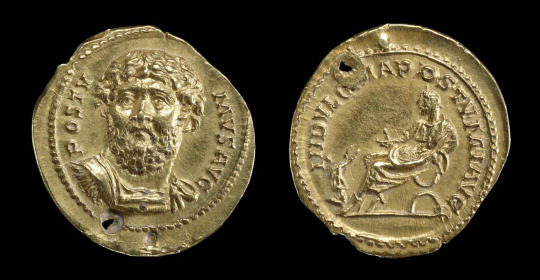
Beautiful Aureus featuring a rare 3/4 Facing bust of Postumus, reverse features Postumus seated, suppliant before him.
71 notes
·
View notes
Text
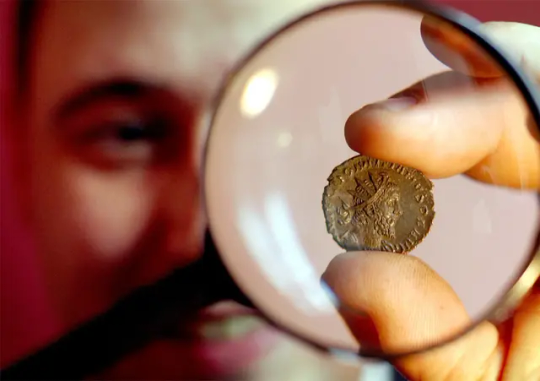
Coin reveals little-known Roman ruler
Treasure hunters have unearthed a coin bearing the head of a virtually unknown Roman ruler who briefly held power in Gaul around A.D. 270 as the empire teetered.
It is only the second coin ever found showing the head of Domitianus, who seized power — and the mint — in the breakaway Gallic Empire, which included modern England, France and parts of Germany and lasted for 15 turbulent years.
“We know next to nothing about Domitianus, except that he was ‘punished’ by the Roman Emperor Aurelian for treason,” Richard Abdy, curator of Roman coins at the British Museum, told Reuters. “But at least now we know what he looked like.”
Studied by coin experts
The first coin bearing Domitianus’ head was found in the Loire area of France in 1900, dismissed as a fake because his name was unknown and then lost from sight in a small museum in Nantes until very recently.
“It is now being studied by numismatists. When I showed our coin to the woman who has been working on it she jumped for joy because it bore out everything she had said about hers,” Abdy said, noting the French coin had been dated to A.D. 271.
The Gallic Empire was established in 260, when rule from Rome was weakening, by Postumus. He was succeeded nine years later by Marius, who held the throne for a matter of weeks before being strangled and in turn replaced by Victorinus, who ruled until 271 when he too was murdered.
Domitianus is believed to have murdered Victorinus, who had a habit of raping the wives of his subordinates, before himself being ousted by Tetricus. Tetricus ruled from 271 to 274, when he was defeated by Aurelian and the empire was restored.
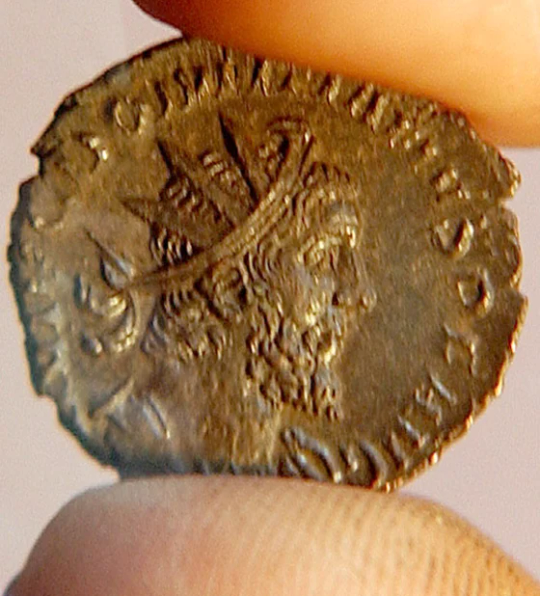
Found on farmland
The British coin, which goes on show at the British Museum starting Wednesday, was found on farmland near Oxford just under a year ago as part of a hoard of 5,000 Roman coins fused together in an earthenware pot.
“It is a type of coin we know as a ‘radiant’ because there are rays radiating from his head. It is a two-denarii piece, which at that time, when they were coining money as fast as they could, would have been worth a couple of hours’ work,” Abdy said.
The base metal coin, which originally had a surface coating of silver, is now conservatively estimated to be worth a five-figure sum, Abdy said.
At the time it was minted, the once-mighty Roman Empire was undergoing a period of intense flux.
The years between 270 and 285 were marked by chaos in the empire, with more than 20 different emperors and 30 different pretenders fighting for power. Only one of these leaders died a natural death.
By Jeremy Lovell.
Original posted Feb. 24, 2004.
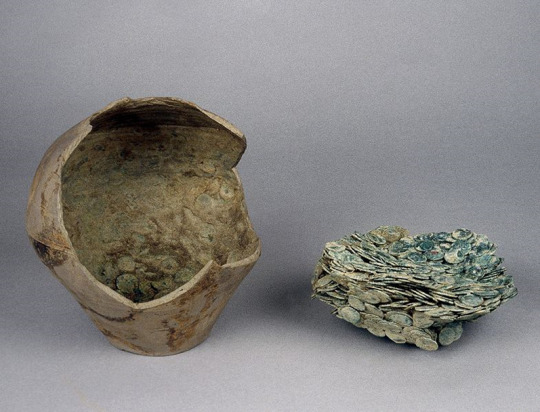

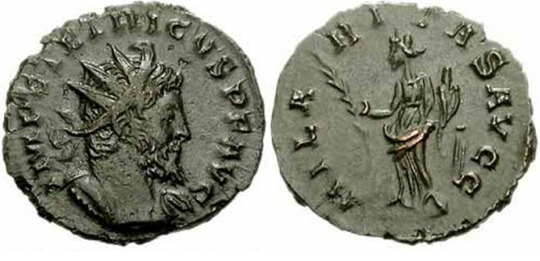
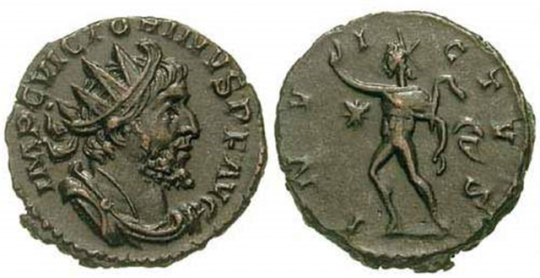
The Coin Hoard
Until this discovery was made some scholars doubted the historical significance of Domitianus who is named just twice in the historical sources. The Oxfordshire coin provides archaeological evidence suggesting that he successfully proclaimed himself emperor of a breakaway part of the Roman Empire during the reign of Aurelian (AD 270-5).
Richard Abdy (Curator of Roman coins at the British Museum) said that ‘during the 270s AD the fabric of the Roman Empire had become strained. Breakaway empires, like the so-called ‘Gallic Empire’ that included Britain, were established and ruled by a succession of rebel emperors. Finding a coin produced in the name of Domitianus means that he should now be recognised as one such rebel emperor.’
The failure of Roman writers to identify him as a rebel emperor even led the only other coin of Domitianus – found in France in 1900 – to be dismissed as a modern fake. The new discovery was struck from the same dies that were used to produce this earlier find and has therefore put its authenticity beyond any doubt.
Ian Leins (Finds Adviser, Iron Age and Roman coins, Portable Antiquities Scheme) said ‘the portrait on the new coin very closely resembles that of the rebel emperors Victorinus and Tetricus. It is highly possible that other coins of Domitianus exist in the collections of museums and individuals but have escaped detection. It is important that people start to pay more attention to these often neglected finds and record them with their local Finds Liaison Officer.’
#Coin reveals little-known Roman ruler#coins#collectable coins#roman coins#rebel emperor#Domitianus#Gaul#Gallic Empire#Aurelian#ancient artifacts#archeology#archeolgst#history#history news#ancient history#ancient culture#ancient civilizations#roman history#roman empire#roman emperor
61 notes
·
View notes
Photo

The Gallic War, 1st century BC.
by LegendesCarto
99 notes
·
View notes
Text
it's midnight but can we PLEASE talk about the use of Greek and Roman mythology in TBOSAS and what it means for each of the characters !!
Ex. Sejanus: Roman soldier, friend and confidant of the Roman Emperor Tiberius until his execution for treason in AD 31
#this is all my brain is thinking about#as a percy jackson AND hunger games kid this is V E R Y important to me#the ballad of songbirds and snakes#the hunger games#diana and apollo as twins??#Juno????#lysistrata is a greek comedy about war?????#gaul?? as in the roman gallic empire??#ARACHNE??? HOUSE OF HADES WHO??#i can talk about this for hours#(and i will)
32 notes
·
View notes
Text

A bone pierced by a spear during the Gallic Wars, 58-50 BC.
#meanwhile in rome#roman empire#gallic wars#julius caesar#grave goods#momento mori#bones#archaeology
15 notes
·
View notes
Text

Gaius Julius Caesar (Jules César) and his army invade Gaul. The shadow of an eagle, symbol of the Roman Empire, appears in the sky.
#julius caesar#jules césar#gaul#rome#romans#ancient rome#roman#army#invasion#art#history#europe#european#france#job#eagle#empire#roman empire#gallic wars#georges montorgueil#jacques marie gaston onfroy de bréville
92 notes
·
View notes
Text
no hate to Vercingetorix (love u bestie), but if i were at the Battle of Alesia 52bc, i would simply ask Caesar to Chill™
#history#shitpost#vercingetorix#Caesar#julius caesar#roman empire#Gallic#ancient celts#celtic rage#celtic#celts#battle#battle of alesia#52bc#this is not to be taken seriously#sca#scadian#calontir#ancient history
6 notes
·
View notes
Video
How Did Julius Caesar Change the Course of History?
#julius caesar#roman history#ancient rome#roman empire#gallic wars#historical figures#military strategy#roman politics#roman civil war#crossing the rubicon#caesar assassination#historical impact#leadership#ancient world leaders#world history#educational history
0 notes
Text

I made a comic after finishing the Gallic Wars, because I can and I thought it was funny.
Script:
Caesar: Now, I like corn as much as the next guy--
Person: Sir, Uxellodunum has a lot of corn.
Caesar: shit... what don't they have?
Person: water, sir
Caesar: take that.
Stick Figure Caesar: WE'RE COMING FOR YOUR WATER!!
#gallic wars#julius caesar#roman empire#the original idea was more a corn joke#but then I forgot which city ran out of corn first#it was originally gonna be caesar mocking that city for running out of corn
0 notes
Text
More random Captive Prince thoughts, because I feel like being a sadist to all of my mutuals these books are living rent-free in my head right now. These ones are more about the plot and the worldbuilding.
Worldbuilding-wise, I loved the attention to detail, because as far as I could tell all the little details of how a medieval-ish army functions and how you would run it and what you would do with the horses and the supplies and the roads etc. etc. were pretty accurate. I mean, these books are by no means a treatise on warfare (in fact they can be delightfully pulpy, which I liked - I grew up on The Three Musketeers and the Scarlet Pimpernell and similar swashbuckling novels, and I got some of the same feelings here!), but there were details in there that most other authors don't bother to put in or inadvertently fuck up (I love ASOIAF to death but historically accurate it is not), and most of the military stuff seemed plausible enough as well, though again not described in too much detail so you can fill it in with your own assumptions or skim over if it's not something that particularly interests you. And I also loved the architectural details and could imagine everything quite well, but again, as I said previously, this may be because the author spent some time living near where I live so we've seen a lot of the same stuff probably.
Actually when I was first reading it and thinking it was going to be bad I was reading it exclusively for the architectural details lol, I was like yeah, yeah, they're all sucking each other off, but Damen please tell me again how you feel about the tiling?
What I also particularly liked is how the... scale of the conflict I guess? was refreshingly accurate for the "historical period".
The worldbuilding is a mashup of Ancient Greece and medieval France, but what it really felt like to me is a world where the Roman Empire never really consolidated to the extent that it did in our world and Italy went on into the middle ages (because these are decidedly feudal systems) with Cisalpine Gaul having the, well, Gallic culture, while the South had a Greek one. I may be thinking this because I live in Italy and so everything reminds me of Italy, but once I thought of it I couldn't unsee it.
I guess I gotta put in a cut somewhere and now's as good of a time as any?
But anyway, back to the scale of the conflict, the actual middle ages were filled with small and mid-sized countries, and petty local conflicts with family members turning onto each other over succession and stuff, and random small territories going back and forth (well, that's just Europe in general, always, TBH), and this is how it all felt like to me. Actual medieval history has a guy who started a rebellion because his brothers threw a pisspot at him and his father did nothing about it and he felt humiliated, and the war was secretly funded by his mother, so the combination of the small scale with a random local conflict that probably literally nobody cares about outside of the region we are in + everything being so intensely driven by interpersonal drama between insane people felt really authentic to me, like the kind of weird historical moment that would get turned into a funny Tumblr post. And of course the royals did a lot more sneaking around than was probably smart, but I can forgive that for the swashbuckling vibes and also because if Cleopatra could sneak into a palace in a carpet these guys can do whatever they want in my book.
Speaking of the petty interpersonal drama, I also liked the emphasis on how in this system personal reputation and the performance of kingship are king. Usually when you have a heavily political story it's much more based on the quid-pro-quo, "rational actor" kind of politics, but medieval politics also had a lot more going on in the cultural sense (and so do modern politics actually but at least pretending to be a "rational actor" IS the modern performance of leadership), and here you had people dealing political blows through meticulous management of their own and others' political reputations, which was fun to see, especially in combination with so many manipulative bastard characters. Like, how Laurent is manipulated into going to the border just because looking like a coward will lose him more political points than he can afford, and Damen's continued wearing of the slave cuff and instistence on not being served by slaves initially deals massive blows to his reputation, because these are cultures that value heroism, of one sort or another.
(And speaking of heroism, the emphasis on the physical activity-related activities that are the centerpiece of noble life in both countries were wonderful, especially since because both Ancient Greece and the European Middle Ages were really into that in their respective ways and it makes the mashup feel really well-done and coherent in how she tied it together.)
What's notable is a lack of any kind of religion, which felt particularly glaring during the whole Kingsmeet thing - in the real world there would likely be a belief in some kinda curse from the Gods or something similar to discourage the drawing of weapons, but since I'm not really religious and tend not to personally care about religion (while ofc recognizing its anthropological importance) I really didn't care and it didn't diminish my enjoyment of the series.
Still, I do have to say that the ending of the last book felt reeeeaally rushed, and that felt really glaring exactly because the rest of the series had such amazing detail work and excellent pacing and very gradual plot development.
I didn't get the part with the doctor and the letter (why didn't he say anything earlier? how would they verify the authenticity of the letter? Did anyone even have the time to READ the thing?) but I'm gonna be honest with you here, I read book 3 under a heavy fever and it was like 2 AM when I got to that part, so I'm not sure that I haven't missed something that makes it make more sense.
BUT even if that part makes sense, I feel like the Regent was dealt with far too quickly. Like in one paragraph he is in control of everything, in the next they've already beheaded him and that's it. I can imagine in my head that a lot of the nobles were probably already sick of him and took little convincing, that they were disapproving both of his meddling in foreign politics and of his likely grave breach of cultural rules via taking an aristo kid as a pet, or that he initially rationally seemed a better choice over Laurent until Laurent proved himself to be more competent and with a more competent ally, or they already had some hints about what happened that the audience didn't and the evidence confirmed what was inconclusive before.
But I feel like in a series that spends so much time detailing the shifting alliances between the characters and the public's opinion on everyone that matters? I really needed to be sold on it a bit more. Like I really needed some discussion over what to do with the Regent, I needed them to keep him in a cell for a while as they decided whether to kill him (and have the leads scared that the Regent will turn them over as Laurent often does to people), I needed them to consider the evidence just a little bit more, I needed some post mortem with the council members where they explain what was happening on their side of the things. It needed to be MUCH longer and more detailed.
Another thing I wondered at was why the Regent was so insistent to paint Laurent's collaborations with the Akielons as a bad thing when he was... also collaborating with the Akielons? Like he is foaming at the mouth calling them barbarians and accusing Laurent of sleeping with the prince-killer but it feels more like setup for Damen's big declaration of love than an actual political strategy because my brother in Christ, you are literally in the Akielon royal palace, in the middle of Akielos to which you ran after your nephew started a rebellion, with the Akielon king sitting next to you as your equal. Why do you think that you can convince your people that YOUR Vere-Akielos alliance is somehow more morally pure than Laurent's? This was also the right moment to pull out all the patricide allegations that seemed to be going around for Damen, but IIRC he didn't use that as much as he could if at all.
Since there were some Akielons in the room as well, I was also wondering WTF was Kastor doing as the Regent was shitting on his country and calling them barbarians and making it like allying with them is a grave transgression? Why was HE allowing this humiliation? It felt like a very unpolitical thing to do from a character whose strength was in his political acumen (obviously meaning the Regent, not Kastor) and the plot just let it slide by.
I feel like a lot of this is due to this being the first time that the story had to fit within the constraints of a traditional book? So it needed a decisive traditional climax and perhaps it was getting too long for a traditional format, or the author got a bit tired of it and wanted to wind it up now that she wasn't getting regular feedback as you do with serialized publishing, or she prioritized emotional impact over plot logic.
I don't know. I still think they're great books, and the conclusion was emotionally satisfying in the sense that the psychological and interpersonal threads were wrapped up impeccably, I just wanted more detail on the political side. It's still grabbed me like nothing else did for a long time, I can take a mid ending, half of my favourite series will never have one at all because the author wrote themselves into a corner and then died lol.
#captive prince#this one's a plot and worldbuilding analysis#I just have so many things to say I'm sorry ._.#they really scratched an itch#RIP to everyone who followed me for anything else (so basically everyone)
123 notes
·
View notes
Text
Ancient Roman 'spike defenses' made famous by Julius Caesar found in Germany
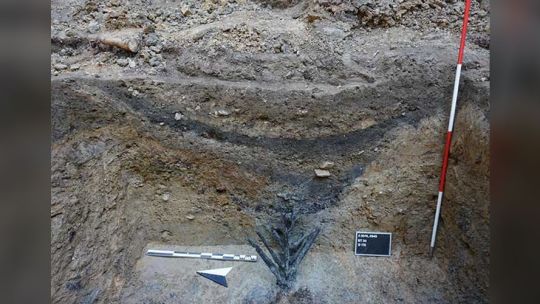
In 52 B.C., Julius Caesar used an ingenious system of ditches and stakes to defend his soldiers from an encroaching Gallic army in modern-day central France. More than two millennia later, archaeologists have discovered the first preserved example of similar defensive stakes, which likely protected an ancient silver mine.
A student team made the unprecedented discovery in the area of Bad Ems, halfway between the present-day cities of Bonn and Mainz in Germany, on the former northern border of the Roman Empire.
Archaeologists have been working in the area of Bad Ems since the late 19th century. Early excavations yielded processed silver ore along with wall foundations and metal slag, so researchers believed that they comprised smelting works dating to the early second century A.D. But in 2016, a hunter noticed odd crop formations and told archaeologists at Goethe University, who later found that the area hosted a 20-acre (8 hectares) double-ditched Roman camp with the remains of around 40 wooden watchtowers. Read more.
336 notes
·
View notes
Note
I mean, whom else are Italians descendants of if not Romans?
Okay, mostly from other Latin tribes, Etruscans, and cisapline Gauls, fair, but who were Romans if not ancestors of at least some of Italians?
Plus, I admit that my knowledge about fate of those Latin tribes is not precise, but I am sure that Italy as a whole was Roman Metropole and I would assume that nobility of those tribes was granted Roman citizenship and then they went to conquer the rest of Mediterranean.
Or you mean that reducing the entirety of Roman Empire to Italy and Greece is wrong? That's also fair (it sucks so much that Rome is considered to be European history and everything popular about it approaches it from this perspective when everything interesting to me was happening in Syria and Egypt), but once again, the ruling class was mostly Latin, therefore ancestors of modern Italians.
(Obligatory note that I am not an Italian so sorry if I am missing on some discourse. I am know that Italian fascists are even more of Roman fanboys than everywhere else, but like, my knowledge of history makes the fact that medieval Italy is descendant to Roman Italy pretty obvious)
Italians are descendants of Romans the same way French are descendants of Gallic tribes. We are not culturally, linguistically, politically the same and even "genetically" because of the migration and conquests that happened after the fall of the roman empire (and again the roman empire even in italy was not that ethnically homogeneous and some of the emperors in the late stage of the empire were north africans and syrians) we are really not the same thing
And yes the only people who trace a direct "lineage" between romans and italians are fascists
20 notes
·
View notes
Text

A GALLO-ROMAN GILT BRONZE MERCURY
CIRCA 1ST-2ND CENTURY A.D.
According to Charles Delaporte's notes, the bronze was found after 1870 during an excavation near the town of Bavay, close to the border with Belgium. During the Roman period, Bavay, then known with the Latin name of Bagacum, was a fortified settlement of the Nervians, described by Julius Caesar as a tribe of fearsome warriors in his account of the Gallic War. The Roman town was founded in 20 B.C. by Marcus Vipsanius Agrippa, one of Augustus' most trusted generals, as part of the Gallia Belgica province. Due to its strategic position as a central node within the network of roads built by the Empire, Bagacum expanded rapidly, becoming one of the most important political and economical centers of the region, with imposing monuments such as a large forum, thermal baths and several temples.
#A GALLO-ROMAN GILT BRONZE MERCURY#CIRCA 1ST-2ND CENTURY A.D.#bronze#bronze statue#bronze sculpture#ancient artifacts#archeology#archeolgst#history#history news#ancient history#ancient culture#ancient civilizations#ancient rome#roman history#roman empire#roman art
31 notes
·
View notes
Photo

Battle of Alesia,52 BC.
by LegendesCarto
61 notes
·
View notes
Text
Lunulae

Lunulae are crescent moon shaped pendants from the Roman Empire. They are -according to statues- pendants which are worn by women. Their use is not based on a set religious rule or idea. They are more thought of as a personal lucky charm.
Since both Romans and Merovingians had a “religion” based on animistic foundations, Gallic and early medieval people saw no reason to discontinue the wear of lunula pendants.
Their execution changed from recognizable crescent moon shapes to a Germanic variant. Most visually, they become wider to allow the use of cloisonné, filigree or kerbschnitt.
Image: buste of a child (Roman-Gallo Roman)
Rijksmuseum van Oudheden, Leiden, Zuid-Holland - The Netherlands.
Museum nr. VF 122
Found in: Bunnik / Vechten, Utrecht - The Netherlands
#frankish#merovingian#viking archaeology#archaeology#carolingian#charlemagne#field archaeology#viking mythology#merovingian archaeology#germanic mythology#norse mythology#anglo saxon#viking#field archaeologist#frisian#odin#vikings#germanic#germanic folklore#germanic archaeology#Ancient Rome#western roman empire#roman empire#wodan#anglo saxon archaeology#history#jewelry#norse
16 notes
·
View notes
Text
Some nations and their birth/death date
- Britannia : born around 800BCE (beginning of British Iron Age); died around 500CE, but she had been getting weaker ever since Rome's forces left.
- Rome : born in 753BCE (Rome's fonding); died in 476CE, for obvious reasons
- Gaul (celtic) : born around 700BCE (between the Halstatt and La Tène cultures); died not long after the Gallic wars in 52BCE
- Germania : born around 750BCE (Nordic Iron Age) died not long after Rome's fall
- Frankish Kingdom/Empire: died in 843 (Treaty of Verdun), son of Germania
- Burgundian Kingdom/State: died in 1482 (end of the Burgundian War of Succession), daughter of Germania
- Frisian Kingdom: died 1523 (end or Frisian Freedom after a failed Frisian rebellion), son of Germania (and is either the biological or the adopted father of the Low Countries (or at least the Netherlands))
- France: born shortly before the Gallic Wars, son of Gaul
- England: born around 500 CE (first Anglo-Saxon kingdoms), he would fully become his "own" in 927 with the Kingdom of England, son of Britannia
- Spain: born somewhere during the Roman era, son of Rome
- Portugal: same as Spain, but earlier, son of Rome
- Netherlands: born shortly before the Roman conquest of Gaul (Belgae), son of idk who yet
- HRE: born in 486CE, when the Franks beat the Soissons Domain; died 1806 for obvious reasons, son of the Frankish Kingdom
- Middle Francia/Lotharingia: born in 843CE (Treaty of Verdun); died either 958CE (division of the Kingdom of Lotharingia) or 1190CE (Lower Lotharingia lost its territorial authority), daughter of the Frankish Kingdom
- Austrasia & Neustria: born in 511CE, died in 751CE, those boys were literally twins and they started the tradition of ✨️fratricide✨️ in the family (later carried on by France killing HRE), sons of the Frankish Kingdom
- Prussia: born 1226CE (creation of the State of the Teutonic Order)/born 1th century CE if we consider him an Old Prussian (Baltic tribe), son of how do I know
- Germany: born...1806(Confederation of the Rhine), 1815(German Confederation), 1866 (North German Confederation) or 1871 (Proclamation of the Reich)
Or he's HRE according to some... I don't know he's complicated...
#feel absolutely free to propose other dates if you don't agree or think there can be another date#very west european/germanic centred sorry :(#i have no idea when Germania's children would be born tho so uh yeah sorry#mes blogs#hetalia#historical hetalia#aph rome#aph germania#aph gaul#aph britannia#aph frankish empire#aph burgundian state#aph frisian kingdom#aph france#aph england#aph spain#aph portugal#aph netherlands#aph hre#aph lotharingia#aph austrasia#aph neustria#aph prussia#aph germany#ill stop here thanks-#hetalia headcanons
42 notes
·
View notes